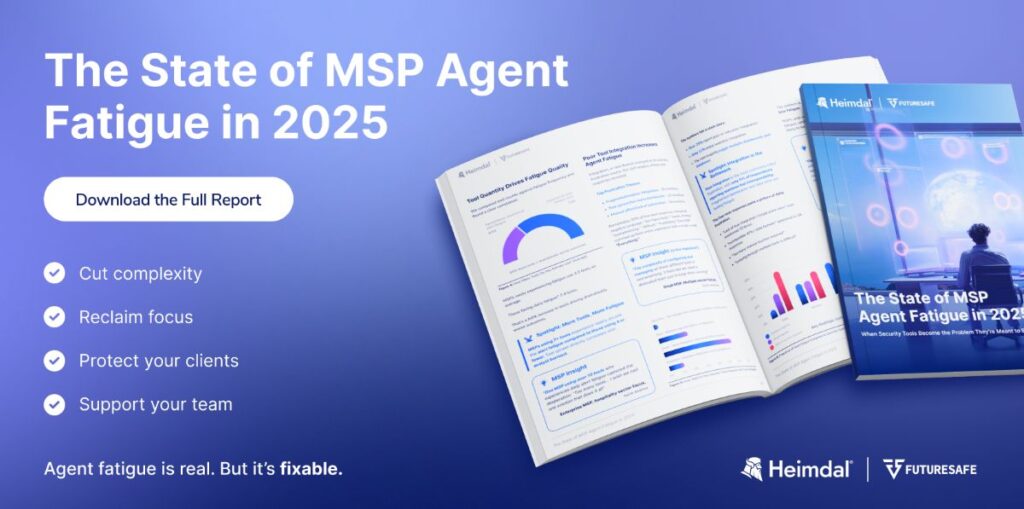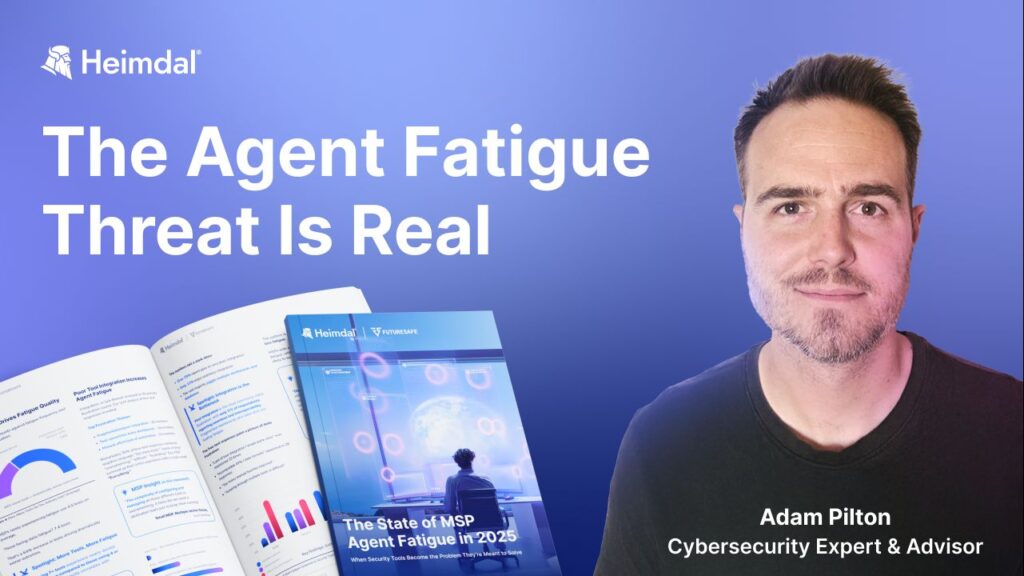Contents:
Your senior analyst stares at alert number 47. It’s not even lunch.
Another “suspicious login detected.”
They switch to the third dashboard of the morning, cross-reference the user activity, and confirm what they already knew.
Bob from accounting is working late again.
Meanwhile, three dashboards over, actual lateral movement is happening on a client’s network. Your analyst will never see it.
Not because they’re incompetent. Because they’re exhausted.
This is agent fatigue.
And if you run an MSP in 2025, your team likely faces it every single week.
The Hidden Tax on Your Business
Let’s talk about the operational math that bleeds MSPs dry. One in four security alerts are false positives. That’s a 25% tax on every hour your team works.
Every investigation. Every escalation. Every middle-of-the-night panic.
MSPs battling high false-positive rates are 2.7× more likely to experience daily fatigue. It’s not just a correlation. It’s a death spiral.
More tools generate more alerts. More alerts include more false positives. More false positives exhaust your analysts. Exhausted analysts miss real threats.
My biggest challenge is seamless interoperability between tools while avoiding data silos, alert fatigue, and configuration conflicts that can reduce overall security effectiveness
— an MSP told us in our Agent Fatigue Report.
It’s less about the threats and more about drowning in their own defenses.
Kevin Lancaster from Channel Program puts it in perspective. He recently spoke with a PE-backed MSP that had rolled up more than 20 smaller MSPs.
Their vendor subscription count? Over 1,000. “You try managing that on an Excel spreadsheet,” Lancaster says. “It’s just chaos. Absolute chaos.”
And that chaos has a price.
Teams with high alert fatigue are 3x more likely to miss actual threats. The very tools meant to enhance security create blind spots through sheer exhaustion.
How We Got Here
This didn’t happen overnight. Lancaster’s data tells the story. When Channel Program launched their stack visualization tool, they assumed MSPs used about 29 different products. MSPs laughed.
The real number? 76 core products, and growing.
“We’ve had about 50,000 products added to stacks,” Lancaster explains.
“Every week, MSPs come asking to add their Privileged Access Management, their EDR, their firewall vendor.”
Three forces created this perfect storm.
- The security landscape exploded. Remote work didn’t just change where people worked. It obliterated the network perimeter. Every home became an office. Every rushed deployment became a vulnerability. MSPs responded the only way they knew how… more tools.
- Compliance became a hammer. GDPR, HIPAA, SOC 2, PCI-DSS. Each framework demanded specific controls. Auditors expected dedicated solutions and MSPs couldn’t say no to tools that checked compliance boxes, even when those tools created operational chaos. As our report shows, 64% of MSPs cite compliance tool costs as a major burden.
- Venture capital flooded the market. Thousands of security startups emerged with each built to solve one narrow problem. Integration was perpetually “on the roadmap.”
The result? What one MSP perfectly captured: “The good thing is having the best of breed. The bad thing is that there is no integration between them.”
The Real Cost of Tired Teams
Forget the vendor invoices. The real cost of agent fatigue compounds daily.
Start with integration, or the lack of it.
Our data shows 89% of MSPs lack seamless tool integration. Teams run what we call the “swivel-chair Olympics,” jumping between dashboards to piece together what’s actually going on.
One small MSP described it this way: “Our apps don’t fully integrate so we have to keep checking multiple platforms or the apps don’t integrate at all and then we waste a lot of time trying to manage all of the platforms and those managing them.”
The operational impact cascades from there.
Billing turns into a nightmare as you reconcile dozens of vendor invoices.
Clients onboarding forces you to configure multiple tools, create numerous accounts, and explain different interfaces.
Our research found 60% of MSPs struggle with billing complexity across their toolset.
But here’s what should really worry you. More security tools lead to more missed threats, not fewer.
MSPs with the highest stacks report the most incidents that slip through.
Lancaster sees the human toll firsthand.
I think that’s going to be kind of one of those hidden epidemics is the fatigue factor within the security market. Take care of your people, people.
He’s right.
When we asked Lancaster about the most important KPI for MSPs, he didn’t mention margins or client retention. He talked about burnout.
It’s one thing that we look at. This marketplace is moving exceptionally fast… People do business with people. You gotta make sure your team is taken care of.”
What the Successful 20% Know
Here’s what gives me hope. Twenty percent of MSPs have already solved this.
They’re not superheroes. They just decided that watching their teams burn out while threats slipped through wasn’t acceptable anymore.
One MSP who successfully consolidated shared this quote: “Not really too frustrated, but I know we can do better and be more efficient.” Notice something?
No desperation. No hair-on-fire panic. Just quiet confidence and continuous improvement.
What separates these MSPs from the 56% still “considering” consolidation?
- They treated it strategically, not tactically. Consolidation wasn’t a weekend project or a panic response to an incident. Leadership committed. They set clear metrics. They involved the team in platform selection instead of forcing tools down from above.
- They migrated gradually. No rip-and-replace disasters. They identified their worst integration gaps, started there, and proved the value before expanding. Dustin Bolander from Beltex advises, “Build that stuff as you go rather than waiting until the last minute to restructure everything.”
- They picked partners, not products. These MSPs chose vendors who understood the consolidation journey and supported the transition. They asked hard questions about integration roadmaps.
Lancaster notes, “Some vendors live and die by integrations because of what they provide and then some kind of turn their nose up at it.”
The results speak for themselves:
- 50% reduction in alert fatigue
- 60–80% fewer false positives
- Single pane of glass for client visibility
- Faster response times to real threats
- Simplified billing and compliance reports
- Teams that are engaged instead of exhausted
Your Roadmap Out of the Chaos
You don’t have to accept agent fatigue as the cost of business. Here’s your practical path forward.
Step 1: Face reality
Lancaster’s advice is blunt. “First thing is just you got to get a grasp on what you have and what the redundancies are.” Audit your stack. List every tool, every integration point, every gap.
The PE-backed MSP with 1,000 subscriptions? They started with a spreadsheet too.
Step 2: Consolidate strategically
The MSPs that succeed don’t just buy bigger bundles. They choose platforms over point solutions. Look for vendors who can replace multiple tools with integrated capabilities.
The math is clear. MSPs that use four or fewer integrated tools report half the fatigue of those with seven or more.
Step 3: Embrace automation (finally)
Only 31% of MSPs have implemented AI or SOAR solutions. That’s not a gap. It’s an opportunity.
Modern automation can triage alerts before they reach your team, correlate events across data sources, and handle routine responses. MSPs that automate report up to 60–80% reduction fewer manual alerts.
Step 4: Rethink compliance
Don’t let auditors dictate your stack. As Bolander puts it, take your compliance frameworks and “bake it into your current processes.”
Modern compliance platforms can map controls once and report to multiple frameworks to stop the need for separate tools for each regulation.
The platform future is here. Lancaster sees the shift. “AI is gonna be this great equalizer because that’s gonna force every product to think how they integrate.”
The vendors who don’t adapt won’t survive. Choose wisely.
The Choice Is Yours
Our research shows an industry at a crossroads. Continue down the current path – more tools, more complexity, more fatigue – and could lose your best people, miss critical threats, and fall behind competitors who’ve figured this out.
The alternative requires courage. Admit your current approach doesn’t work and have tough conversations with vendors. Take time to transform while you fight the daily fires.
But the 20% who’ve done it don’t look back. They’ve stopped the false positives charade.
They don’t spend weekends chasing false positives. They don’t lose analysts to burnout. They don’t have to explain to clients why a threat slipped through a seventeen-tool maze.
Agent fatigue isn’t inevitable. It’s a choice.
The question is, will you join the 20% that take action or stay with the 56% “considering it” while your team suffers?
The data shows the way. The pioneers prove it’s possible. Your team depends on you to act.
Because here’s the truth. This isn’t really about tools or dashboards or integration APIs. It’s about building a sustainable security practice that protects clients without breaking the people who protect them.
The MSPs that win tomorrow will consolidate today. The rest are still switching between dashboards and hope this time will be different.
Which one will you be?










 Network Security
Network Security
 Vulnerability Management
Vulnerability Management
 Privileged Access Management
Privileged Access Management  Endpoint Security
Endpoint Security
 Threat Hunting
Threat Hunting
 Unified Endpoint Management
Unified Endpoint Management
 Email & Collaboration Security
Email & Collaboration Security










